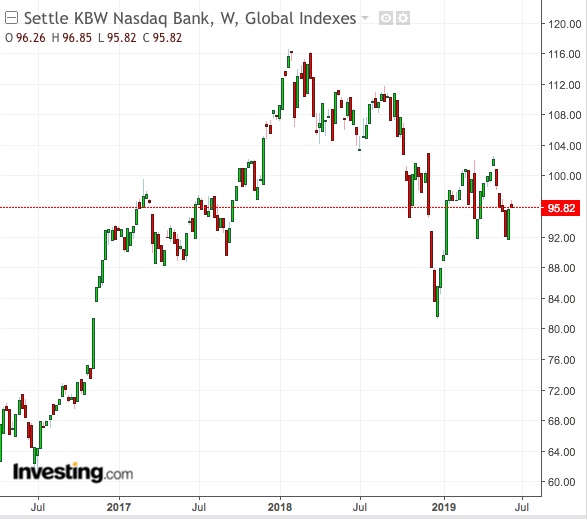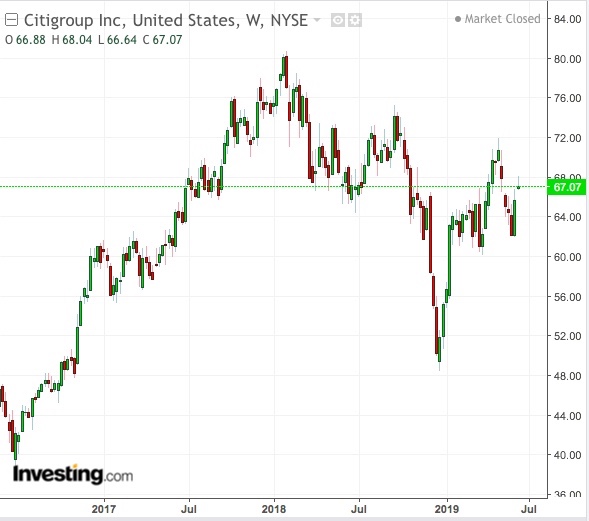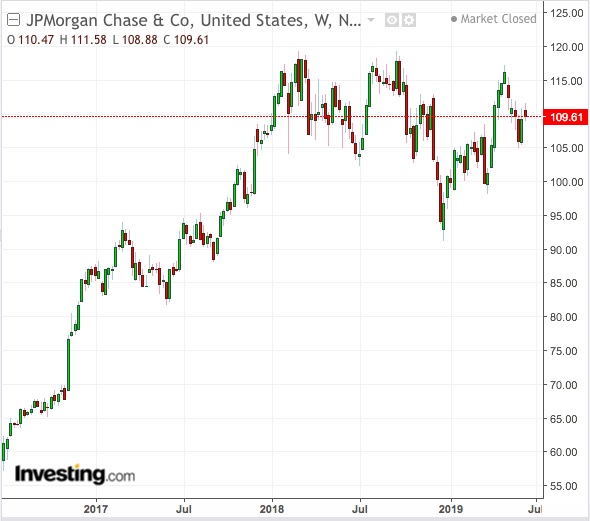The U.S.'s largest banks are entering an uncertain phase. Falling interest rates, low trading volumes, and a threat to the global economy due to the U.S.-China trade war are driving headwinds that could soon hurt their earnings and cloud their future.
These risks are already triggering a sell-off in bank shares as investors shun stocks that are cyclical and closely tied with the health of the global economy. The KBW NASDAQ Bank Index has fallen more than 5% from this year’s high reached in early May.
Over the past year, banking stocks have massively underperformed the S&P 500. That benchmark index has gained about 4%, while the KBW Index has declined about 12% during the same period.

All charts powered by TradingView
Bank stocks — which mirror the general performance of the economy — can also provide an early warning signal to other sectors of the economy which rely on consumer and corporate spending. For example, lenders' stocks soared early this year on signs that the U.S. economic expansion was continuing unabated.
But that optimistic scenario is changing fast. The U.S. Federal Reserve has clearly indicated that it doesn’t want to raise interest rates this year and its next move could be a cut.
Reflecting these bearish sentiments, the yield on the 10-year Treasury note has fallen to its lowest level since the fall of 2017. Falling interest rates narrow the gap between what banks charge borrowers and what they pay depositors, a spread known as the net interest margin.
Second-Quarter Earnings Are at Risk
In an industry conference this week, banking executives at some of the top lenders in the U.S. cautioned investors about the earnings slowdown.
“I’d be very surprised if we beat the first quarter,” Morgan Stanley (NYSE:MS) Chief Executive Officer James Gorman was cited as saying at the conference.
Said Gorman:
“The last two weeks have been quite hard. Up until then, it was solid. We’re not going to have a bad quarter in the securities business, but you’ve got to be realistic with the environment.”
Citigroup Inc. (NYSE:C), on the other hand, is expecting its second-quarter fixed-income and equities trading revenue to fall by a percentage in the “mid-single-digit range” from a year ago, while investment-banking fees are expected to drop by a percentage in the “mid-teens,” according to its Chief Financial Officer Mark Mason.
When looking at individual banking stocks, some have tumbled more than the broader market. Wells Fargo & Co. (NYSE:WFC) is down more than 10% in the past six months, while Bank of America Corp. (NYSE:BAC) has shed 4% in the same period.
But the sour mood around banking stocks doesn’t mean that investors should paint all the names with the same brush. Shares of some of the largest lenders have become attractive after years of restructuring efforts, within a more robust regulatory environment. In this space, we particularly like Citigroup and JPMorgan Chase & Co. (NYSE:JPM).
They've done better than most of their peers over the past six months, with Citigroup up 19% in the period, and JPM gaining more than 8%. Yesterday, Citigroup climbed 0.42% to close at $67.09 and JMP edged 0.28% higher, closing at $109.58.


These banks are well-prepared to cope with any cyclical downturn due to their sustained cost-cutting during the past decade and re-balancing of their portfolios. Their efforts are beginning to pay off and both have been producing strong growth in both revenue and profit over the recent quarters.
Bottom Line
It's certainly not a good time to go long on banking shares when macro headwinds are gathering pace. But in the case of prolonged weakness, we recommend investors get ready to cherry pick some solid banking stocks. For such investors, we like both Citi and JPMorgan, given their earnings momentum, growing dividends and improving balance-sheet quality.
